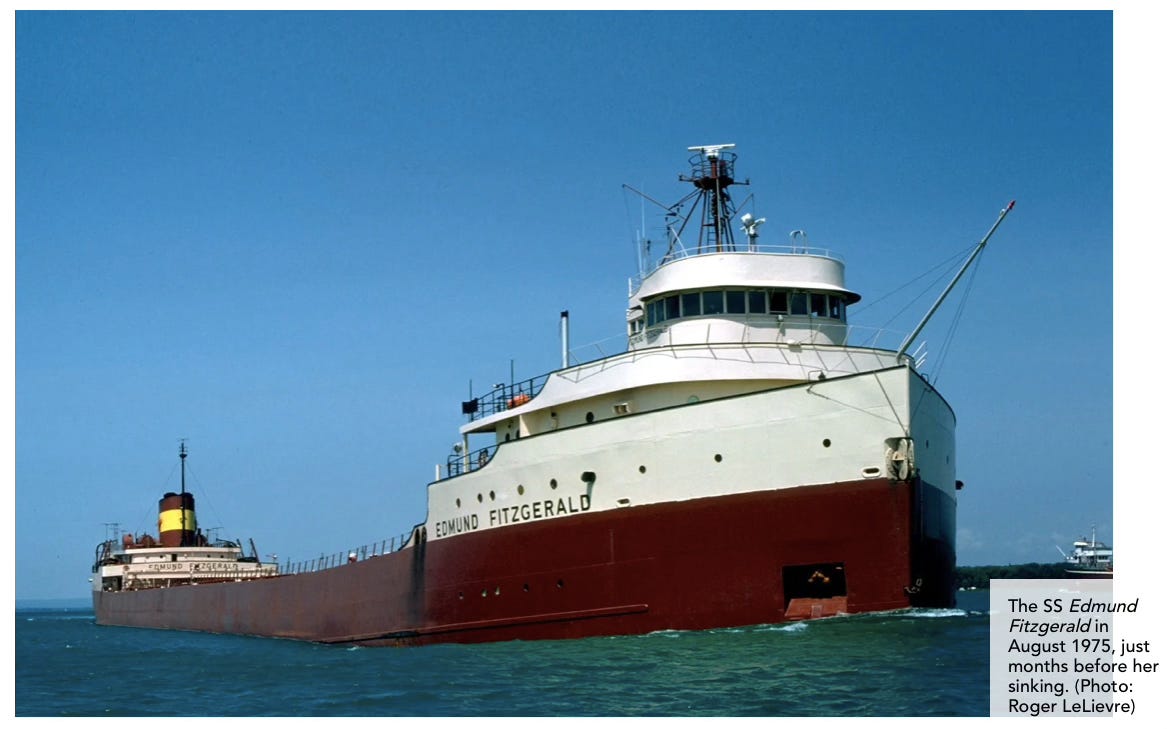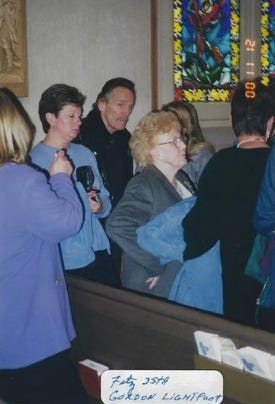'The Dawn Came Late'
Tragedy and song as engines of change
(Bryan Hansel’s ‘Faces of the Dead’ — a photo “taken several years ago during a gale” on Lake Superior, posted here yesterday)
Yesterday was the 50th anniversary of the wreck of the SS Edmund Fitzgerald. The tragedy of its 29-member crew, all lost that day in the icy waters of Lake Superior, still fascinates and astonishes – grist for mills of history, legend and song. Another, more hopeful dimension to this story deserves our attention today.
When launched at Detroit in 1958, the Edmund Fitzgerald measured 222 metres (729 feet). It was the largest ship on the Great Lakes and became their largest shipwreck.
The freighter had been loaded on November 9th at the Burlington Northern Railroad Dock No. 1 in Superior, Wisconsin — just across from Duluth, Minnesota.
Its cargo was mined by the Reserve Mining Company, a subsidiary of Armco Steel (now part of AK Steel), in the Hoyt and Babbitt lakes areas — fifty kilometres from the Canadian border — part of Minnesota’s Mesabi Iron Range, a cornerstone of US steel production since the late nineteenth century. The low-grade silica-rich taconite ore went by rail to Silver Bay on Lake Superior where it was crushed, ground, magnetically separated and pelletized before moving on to port.
These 26,116 tonnes of iron ore pellets — slightly above the Edmund Fitzgerald’s capacity — were destined for National Steel’s Great Lakes Steel division on Zug Island in Detroit, not far from the launch basin where the ship had been christened by Elizabeth Fitzgerald, wife of the Northwestern Mutual Life executive Edmund.
A routine shipment turned to horror. But the wreck had three remarkable results.
First, this was an American bulk carrier with an American crew, filled with American ore steaming towards an American port. But the cargo was mined on Canada’s doorstep. The shipyard was virtually in the shadow of today’s new Gordie Howe International Bridge connecting Windsor-Sandwich and Detroit. Canadian Gordon Lightfoot wrote a six-minute ballad that hit #2 on the Billboard charts, when Rod Stewart’s ‘Tonight’s the Night’ was #1. Lightfoot ended the 1970s with more top ten hits than any folk singer except John Denver. The ‘Wreck of the Edmund Fitzgerald’ became the unofficial ballad of the Great Lakes maritime community.
(The SS Edmund Fitzgerald in August 1975 [Roger LeLievre/Canadian Geographic])
Second, the tragedy sparked activism and reforms in the US and Canada: mandatory survival suits, enhanced radar/forecasting, stricter loading limits, and hull inspections. The Great Lakes Shipwreck Historical Society (GLSHS) was formed in 1976 and the Great Lakes Shipwreck Museum opened at Whitefish Point, Michigan in 1978. Lightfoot himself did concerts for the community there.
Third, according to GLSHS, there were 6,000 commercial shipwreck on the Great Lakes in the century after 1875. Over 250 ships were lost off Whitefish Point alone between 1816 and 1975. From 1945 to 1965, at least 27 commercials vessels of over 100 tonnes went down; seven more from 1965 to 1973. But the SS Edmund Fitzgerald, whose “lights went outta sight” after 7:10 pm on November 10th, 1975, was the last.
(Gordon Lightfoot in the Mariners’ Church in Detroit in 2012)
Canada no longer has active iron ore production on the Great Lakes but Cleveland-Cliffs, ArcelorMittal and US Steel still mine iron ore and taconite in Minnesota’s Mesabi formations and the Marquette Iron Range in Michigan’s upper peninsula, including near Babbitt. Eight US and three Canadian steel mills still operate on the Great Lakes. Zug Island is now a coating operation: primary steel production ended there in 2020, when the Windsor hum also stopped.
For fifty years there have been no shipwrecks of commercial vessels on the Great Lakes. The Fitzgerald was a catalyst for positive change. The legend lives on because a tragedy, a song, civic and government action combined to make things better.





